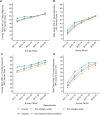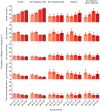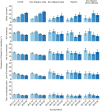Trends in Adolescent Human Papillomavirus Vaccination and Parental Hesitancy in the United States
- PMID: 36869689
- PMCID: PMC10469123
- DOI: 10.1093/infdis/jiad055
Trends in Adolescent Human Papillomavirus Vaccination and Parental Hesitancy in the United States
Abstract
Background: Human papillomavirus (HPV) vaccination coverage remains suboptimal in the United States, underscoring the importance of monitoring trends in vaccine hesitancy.
Methods: Cross-sectional data from the 2011-2020 National Immunization Survey-Teen were used to assess trends in HPV vaccination initiation among 13-17-year-olds, parental intent to initiate vaccination, and primary reasons for parental hesitancy.
Results: Among all sex and race and ethnicity groups, the prevalence of HPV vaccination initiation increased over time, but parental intent to vaccinate against HPV for unvaccinated teens remained consistently low (≤45%). Among hesitant parents, "safety concerns" increased in nearly all demographic groups, with the greatest increases observed for non-Hispanic white female and male teens and no change for non-Hispanic black female teens. In 2019-2020, parents of unvaccinated non-Hispanic white teens were least likely to intend on vaccinating their teens, and the most common reason for hesitancy varied by sex and race and ethnicity (eg, "safety concerns" for white teens and "not necessary" for black female teens).
Conclusions: Although HPV vaccination initiation increased over time, a substantial fraction of parents remain hesitant, and trends in their reason varied by sex and race and ethnicity. Health campaigns and clinicians should address vaccine safety and necessity.
Keywords: NIS-Teen; adolescent health; cancer prevention; racial disparities; vaccine hesitancy.
Plain language summary
Adolescent vaccination against human papillomavirus (HPV) is a critical tool for cancer prevention. We analyzed trends in HPV vaccination initiation among adolescents aged 13–17 years and trends in parental hesitancy to initiate HPV vaccination for their teen, using data from a national survey in the United States. Between 2011–2012 and 2019–2020, adolescent HPV vaccination initiation increased over time for both female teens (from 53.4% to 75.2%) and male teens (from 14.5% to 71.5%). However, the majority of parents/guardians of unvaccinated teens did not intend to vaccinate their teen against HPV (ie, were vaccine hesitant), and this was consistent over time in all sex and race and ethnicity groups. Among hesitant parents, the proportion reporting safety concerns as their main reason for being hesitant increased over time in nearly all demographic groups, with the greatest increases in this reasoning observed for white teens. In 2019–2020, parents of unvaccinated white teens were most likely to be vaccine hesitant. The most common reason for being vaccine hesitant also differed by sex and race and ethnicity. Although HPV vaccination has been shown to be safe and effective, HPV vaccination coverage remains suboptimal, and a substantial fraction of parents/guardians continue to be hesitant to adolescent HPV vaccination.
© The Author(s) 2023. Published by Oxford University Press on behalf of Infectious Diseases Society of America. All rights reserved. For permissions, please e-mail: journals.permissions@oup.com.
Conflict of interest statement
Potential conflicts of interest. All authors: No reported conflicts. All authors have submitted the ICMJE Form for Disclosure of Potential Conflicts of Interest. Conflicts that the editors consider relevant to the content of the manuscript have been disclosed.
Figures






Similar articles
-
Levels of Parental Human Papillomavirus Vaccine Hesitancy and Their Reasons for Not Intending to Vaccinate: Insights From the 2019 National Immunization Survey-Teen.J Adolesc Health. 2022 Jul;71(1):39-46. doi: 10.1016/j.jadohealth.2022.01.223. Epub 2022 Mar 9. J Adolesc Health. 2022. PMID: 35279361 Free PMC article.
-
Variations in reason for intention not to vaccinate across time, region, and by race/ethnicity, NIS-Teen (2008-2016).Vaccine. 2019 Jan 21;37(4):595-601. doi: 10.1016/j.vaccine.2018.12.017. Epub 2018 Dec 21. Vaccine. 2019. PMID: 30580838 Free PMC article.
-
National Trends in Parental Human Papillomavirus Vaccination Intentions and Reasons for Hesitancy, 2010-2015.Clin Infect Dis. 2018 Sep 14;67(7):1018-1026. doi: 10.1093/cid/ciy232. Clin Infect Dis. 2018. PMID: 29596595 Free PMC article.
-
HPV vaccine hesitancy in the United States.Curr Opin Pediatr. 2025 Apr 1;37(2):198-204. doi: 10.1097/MOP.0000000000001441. Epub 2025 Jan 22. Curr Opin Pediatr. 2025. PMID: 39882684 Review.
-
Human Papillomavirus Vaccine Hesitancy in the United States.Pediatr Clin North Am. 2023 Apr;70(2):211-226. doi: 10.1016/j.pcl.2022.11.002. Pediatr Clin North Am. 2023. PMID: 36841591 Review.
Cited by
-
Barriers to COVID-19 Vaccination and Perceptions Around Vaccination Uptake Strategies Among African Americans Living in the US South: Opportunities for Public Health Program Intervention.J Racial Ethn Health Disparities. 2025 Apr 28. doi: 10.1007/s40615-025-02433-6. Online ahead of print. J Racial Ethn Health Disparities. 2025. PMID: 40293689
-
Factors influencing adolescents' decision-making about COVID-19 vaccination: a systematic review with qualitative synthesis.Front Public Health. 2025 May 14;13:1563677. doi: 10.3389/fpubh.2025.1563677. eCollection 2025. Front Public Health. 2025. PMID: 40438050 Free PMC article.
-
Characterizing adolescent vaccination in publicly funded national immunization programs in Latin America and the Caribbean: A review of the literature.Hum Vaccin Immunother. 2025 Dec;21(1):2528403. doi: 10.1080/21645515.2025.2528403. Epub 2025 Jul 11. Hum Vaccin Immunother. 2025. PMID: 40643044 Free PMC article.
-
Graduate and Health Professional Student Knowledge, Attitudes, Beliefs, and Behavior Related to Human Papillomavirus and Human Papillomavirus Vaccination: A Scoping Review of the Literature.Vaccines (Basel). 2024 May 7;12(5):507. doi: 10.3390/vaccines12050507. Vaccines (Basel). 2024. PMID: 38793758 Free PMC article.
-
HPV Vaccination Information Access, Needs, and Preferences Among Black and Hispanic Mothers.J Health Commun. 2024 Sep;29(9):566-579. doi: 10.1080/10810730.2024.2386594. Epub 2024 Aug 11. J Health Commun. 2024. PMID: 39129253
References
-
- McQuillan G, Kruszon-Moran D, Markowitz L, Unger E, Paulose-Ram R. Prevalence of HPV in adults aged 18–69: United States, 2011–2014. NCHS Data Brief 2017; 280:1–8. - PubMed
Publication types
MeSH terms
Substances
Grants and funding
LinkOut - more resources
Full Text Sources

